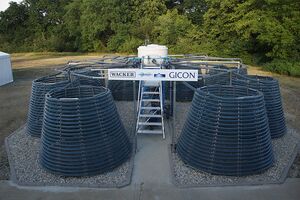GICON® Photobioreactor to produce microalgae for Saxon pigs from 2020

The rapidly renewable raw material is intended, among other things, to promote animal welfare and minimize the use of antibiotics. Through this innovative thinking, regional agriculture can be practiced even more sustainably and courageously. Science, agriculture and the Saxon state government are successfully continuing the networking and cooperation between research and practice.
With the pilot project "AlgaPork", the Agraset-Agrargenossenschaft eG in Naundorf, Saxony, will investigate microalgae as an additive to the feed mix for more than 3500 fattening pigs. The algae biomass will be produced directly on the farm using the innovative GICON® Photobioreactor system. The project is being scientifically supported by the University of Rostock. The fodjan GmbH from Dresden is providing the software for data acquisition and evaluation. All four partners (GICON®, fodjan, the University of Rostock and Agraset-Agrargenossenschaft) are working together in an operational group within the European Innovation Partnership "Agricultural Productivity and Sustainability" (EIP AGRI). For the pilot project, subsidies of around EUR 690,000 were granted on the basis of the funding directive Agriculture, Innovation and Knowledge Transfer - RL LIW/2014 of the Saxon State Ministry for the Environment and Agriculture.
Innovative system for the future
Microalgae are unicellular, fast-growing plants that can be cultivated using less land and water consumption than terrestrial plants. Together with its partners, Anhalt University of Applied Sciences and Wacker Chemie AG, GICON® has succeeded in developing the innovative GICON® Photobioreactor (PBR) system. The PBR is based on a conical supporting structure reminiscent of the shape of a Christmas tree. A double-chamber tube made of resistant, low-maintenance silicone is placed on this adaptable frame. Due to the separate flowing of the algae mass in one chamber and water for tempering in the second chamber, the GICON® PBR can be used all year round and worldwide. Several patents have been applied for this system- and process-engineering solution. In addition to the Central German Biosolar Center at the University of Applied Sciences in Köthen, GICON® also operates an industrial demonstration plant with a GICON® PBR Octagon at the Cottbus site.
Less land use for feed production
The Dresden-based engineering services provider has taken over project management and process engineering support for the project, which will run until 2022. This includes the production and mixing of the continuously produced algae biomass. GICON® project manager Dr. Jan Hoyer formulates the goal in advance, "that we want to show that high-quality and fresh microalgae biomass can be produced as animal feed supplement with little technical and personnel effort on the farm. In the long term, this will make it possible to reduce the use of land for the production of animal feed enormously". At the same time, the focus is also on health-promoting and economical use - for example, the effects of microalgae on the intestinal flora and growth of pigs, as well as the reduction of operating costs. "In the medium term, we would like to open up the market for animal feed supplements with microalgae and see great potential for the use of GICON® PBR on farms," says Dr. Hoyer. "In an earlier project with laying hens, we were able to demonstrate the positive influence of microalgae on animal welfare and animal health". Farmers, scientists and engineers hope that the addition of algae biomass will especially reduce the addition of antibiotics, which in turn will increase consumer acceptance.
Microalgae will be produced beginning in summer 2020
The project is starting with preliminary work at the University of Rostock to show the first effects of the microalgae in laboratory experiments, but the first microalgae are expected to be produced using GICON® PBR as early as summer 2020. Controlled addition to animal feed will then begin in 2021.